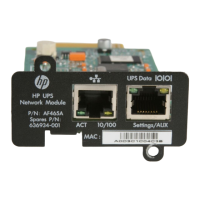SCS commands 54
Example
The following command copies the alert strings defined on port 1 to port 17, replacing any previously defined alert
strings on port 17.
port 17 alert copy 1
Port Alert Delete
The Port Alert Delete command deletes one or more alert strings from a port. When you issue this command, a
numbered list of defined alert strings appears, from which you choose those to be deleted. You can enter one or more
numbers separated by commas, a range of numbers separated by a hyphen, or enter All to specify all strings.
Pressing the Enter key cancels the command. See “Managing the SCS using SNMP.”
Access right: SCON or PCON
Access level: ADMIN or APPLIANCEADMIN
Syntax:
port <port> alert delete
Table 5-8 Port Alert Delete command parameter
Parameter Description
<port> Port number or name
Example
The following command deletes defined alert strings from port 26.
> port 26 alert delete
Alert-strings assigned to port 26:
1) The first alert string
2) The second alert string
3) The third alert string
4) The fourth alert string
Select Alert-string(s) to delete>
The alert string numbers specified at the prompt will be deleted.
Port Break
The Port Break command sends a serial break signal to the device to which you are attached.
Access right: BREAK
Access level: ADMIN or APPLIANCEADMIN
Syntax:
port break
Port History
The Port History command accesses the history mode of a serial port while you are attached to the port. When
you are in history mode, the port history> prompt appears, and you can search the port history buffer for
specified strings. See “Managing port history.”
Access right: None needed
Access level: All
Syntax:
port history
When you are in port history mode, you can issue the commands listed in Table 3-6.

